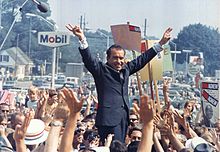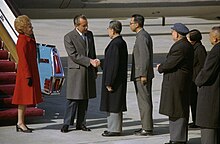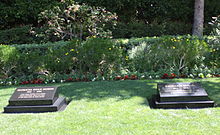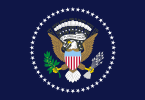Richard Nixon
Richard Nixon | |
|---|---|
 Oval Office Photoc. 1972 | |
| 37thPresident of the United States | |
| In office January 20, 1969 – August 9, 1974 | |
| Vice President |
|
| Preceded by | Lyndon B. Johnson |
| Succeeded by | Gerald Ford |
| 36thVice President of the United States | |
| In office January 20, 1953 – January 20, 1961 | |
| President | Dwight D. Eisenhower |
| Preceded by | Alben W. Barkley |
| Succeeded by | Lyndon B. Johnson |
| United States Senator fromCalifornia | |
| In office December 1, 1950 – January 1, 1953 | |
| Preceded by | Sheridan Downey |
| Succeeded by | Thomas Kuchel |
| Member of theU.S. House of Representatives fromCalifornia's12thdistrict | |
| In office January 3, 1947 – November 30, 1950 | |
| Preceded by | Jerry Voorhis |
| Succeeded by | Patrick J. Hillings |
| Personal details | |
| Born | Richard Milhous Nixon January 9, 1913 Yorba Linda, California,U.S. |
| Died | April 22, 1994(aged 81) New York City,U.S. |
| Resting place | Richard Nixon Presidential Library and Museum |
| Political party | Republican |
| Height | 1.79 m (5 ft 10 in) |
| Spouse(s) | |
| Children | Tricia Julie |
| Mother | Hannah Milhous |
| Father | Francis A. Nixon |
| Education | Whittier College(BA) Duke University School of Law(JD) |
| Religion | Quakers |
| Signature | |
| Military service | |
| Allegiance | |
| Branch/service | |
| Years of service | 1942–1946 (active) 1946–1966 (inactive) |
| Rank | |
| Battles/wars | World War II •South Pacific Theater[1] |
| Awards | |
Richard Milhous Nixon(January 9, 1913 – April 22, 1994) was an American politician who was the 37thpresident of the United Statesfrom 1969 to 1974, when he became the only president to resign.[2]Before that, Nixon was the 36thvice president(from 1953 to 1961 underPresident Dwight D. Eisenhower), and a U.S. Representative and Senator from California. He was aRepublican.
Nixon was born inYorba Linda, California.He attendedDuke Universityand graduated from its law school in 1937. After graduating, he returned to California to practice law. In 1942, he and his wife Pat moved to Washington to work for the federal government. DuringWorld War II,he served on active duty in the Naval Reserve.
Nixon began his career in politics after he was elected to theHouse of Representativesin 1946. During this time, he became well known as an anti-Communist. In 1950, he was elected to theSenate.In 1953, he became the vice president of the United States, under President Dwight D. Eisenhower. He served in this position for eight years. In 1960, Nixon ran for president. He was defeated byJohn F. Kennedy.Two years later, in 1962, Nixon ran for governor of California. He also lost this election toPat Brown.In1968,he ran for president for a second time. He won the election, defeatingHubert HumphreyandGeorge Wallacein a close election.
As president, Nixon got the United States to stop being involved in theVietnam War.He ended the military draft in 1973. In 1972, Nixon visitedChina.This visit would eventually create diplomatic relations between the two nations. The same year, he signed the Anti-Ballistic Missile Treaty with theSoviet Union.
Domestically, Nixon imposed wage and price controls for 90 days. He had Southern schools desegregated (ending the separation of people by their race). He established theEnvironmental Protection Agency (EPA)as well as the Occupational Safety and Health Administration (OSHA). He also began the War on Cancer. He presided over theApollo 11Moon landing in 1969. In1972,Nixon was re-elected in a landslide, defeatingGeorge McGovern.
In his second term, Nixon ordered an airlift to resupply Israeli losses in theYom Kippur War,a war which led to the oil crisis at home. In 1973, he had lost a lot of political support because of theWatergate scandal.On August 9, 1974, Nixon resigned, becoming the first American president to do so. His successor,Gerald Ford,pardoned him.
After resigning, Nixon wrote many books and visited many other countries. He died on April 22, 1994, after suffering a stroke. He is ranked lowly in presidential opinion polls.[3][4][5]Despite this, evaluations of Nixon have been difficult, as he was viewed to have accomplished good things as president, even though he resigned due to a scandal.
Early life, belief & Californian heritage
[change|change source]
Nixon was born on January 9, 1913[6]in his family's home in Yorba Linda,California,to Hannah and Francis Nixon. He is the only president born in California. He was named for King Richard the Lionhearted, and was raised as aQuaker.His brotherEdward,was a businessman.Herbert Hooverwas the only other United States President to belong to the Quaker faith (as a coincidence, Hoover was also one of just three presidents, one of whom was Nixon, to hail from California). Nixon was raised inWhittier, California.His father was of Scotch-Irish ancestry and his mother was of German, English, and Irish ancestry.[7]He attended Whittier High School, Whittier College, andDuke University.[6]He served in the Navy duringWorld War II.[8]Later, he married Thelma Nixon (later Patricia Nixon) and had two daughters, Tricia and Julie.[6]
Harvard Scholarship & More
[change|change source]Nixon received a scholarship to Harvard, but declined to help his family on the farm. Nixon was also tapped to join theFBI.He was very pleased, but at the last minute was rejected due to budget cuts.
Early political career
[change|change source]
Congressional career
[change|change source]California congressman (1947–1950)
[change|change source]Nixon was elected to the House of Representatives in 1946. When in the House, he was a member of House Un-American Activities Commission, a group of Congressmen that tried to expose people in the United States who might have beenCommunists.
U.S. Senate (1950–1953)
[change|change source]He was later elected a Senator in 1950 after running a controversial campaign against Helen Gahagan Douglas.
Vice president (1953–1961)
[change|change source]In the 1952 presidential election,Dwight D. Eisenhowerselected Nixon to be vice-president. People accused him of receiving illegal money contributions to his campaign and some people wanted Eisenhower to pick a different vice president, but Eisenhower still kept Nixon. Nixon after the accusations made a speech saying that no matter what people accuse him of illegally receiving during the campaign, he is still going to keep one campaign gift: his dog named Checkers.
The Republican Party decided to keep Nixon as their vice-presidential candidate and when Eisenhower won the election, Nixon became vice-president of the United States from 1953 to 1961. During his vice-presidency, he was very busy and traveled across the world to places likeSouth America.While he was vice president, he went to the Soviet Union and had a debate with the Soviet leaderNikita Khrushchev.They were both arguing that their country was better.
1960 presidential election
[change|change source]In the presidential election of 1960, he ran againstDemocratJohn F. Kennedy.Kennedy was expected to win at first (because he won the first television debate against Nixon), but as Election Day came closer and closer, Nixon was catching up. In the end, Kennedy won, but it was a very close election.[6]
1962 California gubernatorial election
[change|change source]In 1962, Nixon lost the election for governor of California toPat Brown.After losing, Nixon said "you don't have Nixon to kick around any more, because, gentlemen, this is my last press conference.", leading many experts to say that Nixon's political career was over.
1968 presidential election
[change|change source]
In 1968, Richard Nixon defeatedHubert Humphreyin the presidential election and became president of the United States in 1969. Although Humphrey lost the popular vote narrowly, he lost the electoral college in a landslide, carrying just fifteen states.
Presidency, 1969–74
[change|change source]
Nixon took over theVietnam WarfromLyndon Johnsonand continued it with the strategy of slowly withdrawing U.S. troops, so that theSouth Vietnamesetroops could take over the fighting by themselves. Nixon secretly bombed many enemy targets inCambodiaandNorth Vietnamwhile bringing home the American troops, to make it easier for South Vietnam to win. When his spreading the bombing to Cambodia andLaosbecame known in 1970, it caused larger protests than ever in America, including at Kent State and even inWashington, DC,where more than 12,000 were arrested in May 1971 at the peak of the protests. Partly because of the amount of opposition, Nixon sped up troop withdrawal and ended the draft.


Nixon was very successful in diplomacy (relations negotiations with foreign countries). He began a policy called "détente" which reduced tensions between the United States and the Soviet Union. The two countries would get along and sign treaties that would limit the production of nuclear weapons between both sides. Nixon traveled to communist China and established a very good relationship with them. Before that, there was almost no relationship between the United States and China. It opened up the door for decades of trade in the future, which is why many items in the United States were made in China. His diplomacy with China is seen as one of his greatest accomplishments. Later, under President Carter, the U.S. broke relations with the Republic of China and recognized communist China, not Taiwan, as the legal government of China.
At home, Nixon put many reforms into law. He created the Environmental Protection Agency,[9]supported anti-drug laws, supported anti-crime laws, and supported anti-discrimination laws. When inflation (meaning the value of money goes down and prices go up) was high, he ordered that prices should be frozen for 90 days. Although, he was known as aconservativeRepublicanbefore he became president, while he was president, he supported some of theliberalideas thatDemocratssupported. In 1974, Nixon made a speech that outlined a plan for universal health care.

Nixon was re-elected by a landslide in 1972 with most Americans approving of him, but soon after, Nixon's reputation would be destroyed and most Americans would disapprove of him. Due to a scandal called "Watergate"during which Nixon attempted to protect (or possibly ordered) men to burglarize the Democratic National Headquarters, Congress was going to put him on trial in a process called impeachment (to remove him from power). Nixon tried to cover up the scandal, but eventually, the Supreme Court ordered him to send his taped conversations (which included him talking about covering up Watergate) to them. Alexander Haig thought Nixon would be convicted and kicked out of office. To prevent this, Nixon resigned (quit) the presidency in 1974.
Post-presidency
[change|change source]
Nixon's second vice president,[6]Gerald Ford,gave Nixon apardonof any crimes Nixon committed during Watergate. Ford wanted to end the crisis as quickly as possible, because the nation faced more important problems. Many people blamed Ford for letting Nixon go free, and voted against him when he ran in the 1976 election.

Nixon's public image never fully recovered, but he still got some approval back from Republicans as he frequently defended his legacy. He remained as aconsultantto later Presidents, and to other people in government and themediaespecially toBritishjournalistDavid Frost.Hismemoirsare considered important readings.[6]His work in negotiating withChinain the early 1970s was praised for improving relations between his country and theirs.[6]Nixon died of astrokein 1994,[6]ten months after his wife Pat died. Not being able to defend his legacy any longer, his overall approval rating fell, and most everyone today acknowledges his wrongdoings related to Watergate. The house where he was born is now part of the Richard M. Nixon Presidential Library and Museum. He was buried at the library.
Related pages
[change|change source]References
[change|change source]- ↑Richard Nixon Presidential Library and Museumhttp://nixon.archives.gov/thelife/nixonbio.pdfArchivedSeptember 21, 2015, at theWayback Machine
- ↑Wright, John (2001).The New York Times Almanac 2002.Routledge. p. 96.ISBN978-1-57958-348-4.
- ↑"Lincoln Wins: Honest Abe tops new presidential survey".CNN.February 16, 2009.RetrievedDecember 2,2020.
- ↑"Presidential Historians Survey 2017".C-SPAN.RetrievedDecember 2,2020.
- ↑"Presidents 2018 Rank by Category"(PDF).RetrievedDecember 2,2020.
- ↑6.06.16.26.36.46.56.66.7"Richard M. Nixon".Retrieved2009-12-06.
- ↑"Nixon Genealogy - President Richard Nixon Family History".archives.
- ↑White, Theodore H. (1973).The Making of the President 1972.New York: Antheneum. p.123.ISBN978-0-689-10553-1.
- ↑Elkins, Chuck (October 2013)."Transcript of" Behind the Scenes at the Creation of the EPA "Video"(PDF).EPA Alumni Association.RetrievedAugust 20,2018.
Other websites
[change|change source]- Presidents of the United States
- 1913 births
- 1994 deaths
- Lawyers from California
- Deaths from stroke
- People from Whittier, California
- People of the Vietnam War
- Quakers
- Recipients of the Nishan-e-Pakistan
- Richard Nixon
- Time People of the Year
- 1960 United States presidential candidates
- 1964 United States presidential candidates
- 1968 United States presidential candidates
- 1972 United States presidential candidates
- United States representatives from California
- United States senators from California
- Republican Party (United States) politicians
- Yorba Linda, California
- 20th-century American politicians
- Anti-communists
- Watergate scandal


